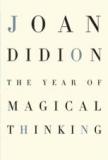In Widow's Weeds
Joan Didion has been writing books for more than 40 years. When she was introduced at a reading of her newest and most unforgettable book, The Year of Magical Thinking, at a giant Barnes & Noble store in New York last fall, there was a catch in the voice of the teary-eyed woman who hosted the event, as she presented the frail-looking Didion to a standing-room-only audience.
People who have recently lost someone have a certain look, recognizable maybe only to those who have seen that look in their own faces.
Nearly everyone in the crowd was carrying the new book—many held more than one copy—in anticipation of having it autographed, but perhaps mostly of meeting the writer, whose dozen previous books they had likely devoured.
There was always something special about a Joan Didion book. Most were thin and long-shaped—elegant in their way. The cover’s typeface was perfect, in the way Ann Taylor’s logo is perfect. Sometimes there would be a photo of the author on the dust jacket that could make one fall in love, the way many fell in love with the young Mia Farrow. To be with Joan Didion was to be in a stylishly arranged world—no matter the sometimes depressing seriousness of the subjects—for a few hundred well-designed pages.
Her writing—especially her essays, for which she is best known and which drew the crowd to the store—is elegant, refined and personal. Nobody dresses a sentence in precise detail the way this author does. That one of her two most famous essay collections is entitled TheWhite Album is no surprise.
We were married on the afternoon of January 30, 1964, a Thursday, at the Catholic Mission of San Juan Bautist.... John wore a heavy blue suit from Chipp. I wore a short white silk dress I had bought at Ransohoff’s in San Francisco on the day John Kennedy was killed.
So it hits the reader hard to hear that Joan Didion’s life had fallen off the mantel and shattered. Her husband and partner, the writer John Gregory Dunne, who was with her during all those years of writing books, had died one evening while they ate together in their Manhattan apartment. These were the first words she wrote afterward, which open her memoir of her time alone:
Life changes fast.
Life changes in the instant.
You sit down to dinner and life as you know it ends.
The question of self-pity.
It was the night before New Year’s Eve 2003, and Joan and John had just returned from the hospital, where their 39-year-old adopted daughter Quintana Roo was under treatment for severe reactions to the flu. (Readers were aware of the daughter with the curious name over the years from book dedications and photo credits.) While Dunne was on the second Scotch that Didion had poured for him, he stopped his part of the conversation that had been going on between them for 40 years and fell off his chair to the floor. Life changes fast. Life changes in the instant.
The minutes and hours and days from then on are described by Joan Didion in her special way. As she has always done, she burrows into the piles of details to learn about what happened. She works to learn the language of emergency rooms and autopsies. She asks the apartment building’s elevator operator what he remembers. She retraces that night and the death that occurred. She talks to herself and puts quotation marks around her words. She lets the readers in, so that they grasp her solitude and loss in ways they had never thought about such solitude and loss before, and in ways Didion hadn’t either:
I used to tell John my dreams, not to understand them but to get rid of them, clear my mind for the day. "Don’t tell me your dream," he would say when I woke in the morning, but in the end he would listen.When he died I stopped having dreams.
That is what makes her writing so riveting: It exposes her mind. She had thought it would be very different. Not only did she never imagine a scenario in which John would die before she did, while sitting with her at dinner, but she was unprepared for the magical thinking she would embrace in the aftermath. When the hospital called to ask if she would donate her husband’s organs, she found herself thinking, "How could he come back if they took his organs?" Then, while packing up his clothes to take to Goodwill, she asked herself, "How could he come back if he had no shoes?"
There is beauty in Didion’s recollections of their life together: the California homes, the meals with literary friends and movie people, the dinners with just the two of them together, the swimming pools, the travels, the clothes—recollections that evoke a mood, an atmosphere. She gives the reader what the reader appreciates most. That is what makes even Joan Didion’s sad tale somehow stimulating to read. Wherever she finds herself, be it in sunlight or loneliness, her experience is palpable to the reader, who is transported to where she is—and wants to be there with her.
The voice on my answering machine is still John’s.
This article also appeared in print, under the headline “In Widow's Weeds,” in the February 13, 2006, issue.








